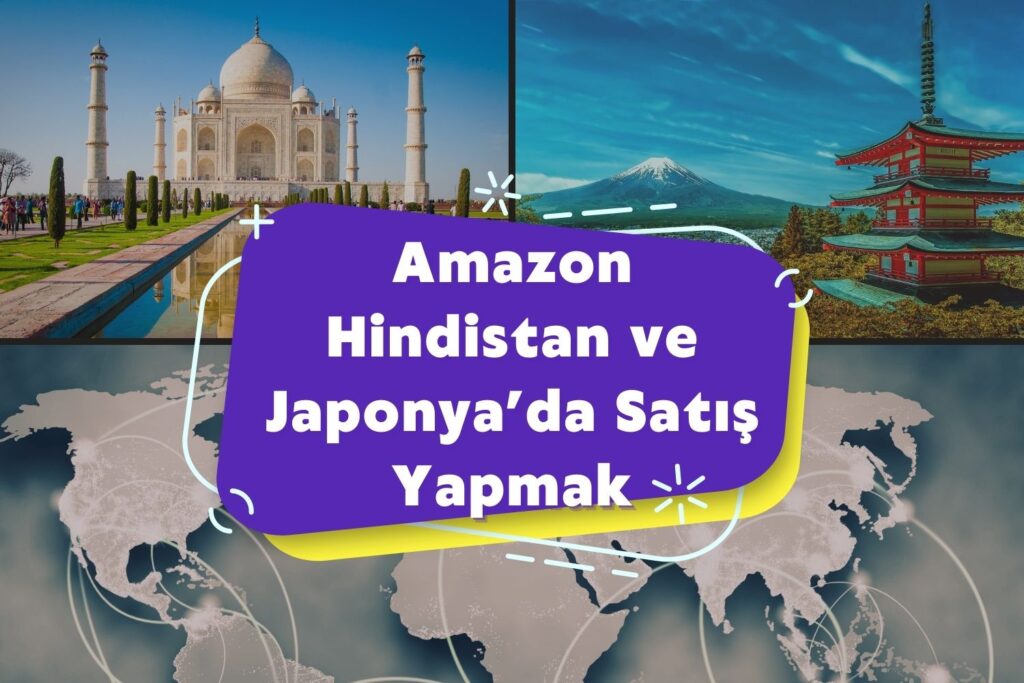
What is VAT? Why is it necessary?
Blog Content Why is VAT Registration Necessary in Europe? WHAT IS VAT REGISTRATION? Value Added Tax is the abbreviation of the word VAT, which

As everywhere else, the first thing to do in business is to first work on a functional business model and follow the model you’ve created. Then you can set sail towards your new adventure by following the steps below;
Find a Product People Will Want to Buy
The first thing you need to do before you start selling on Amazon India is to find a product that people will want to buy and that can meet Indian culture and people’s wishes. According to him, it is quite difficult to achieve this. It is useful to remind that; There is no such thing as a product that has achieved high success in Amazon America or the UK, will also achieve high success in the Indian market.
The most important thing when choosing a product is to choose a product that can meet the wishes and needs of the people living in India and that will not contradict the culture of the people living in that geography, and if possible, get strength from it.
One right product will be quite enough for entry, but when you want to grow your business and make big profits from this market, you will have to expand your product portfolio.
However, since this kind of work will take a bit of trial and error, do not hesitate to sell the products that you will be suitable for by risking some loss. In order to avoid possible loss and reduce your risks, be sure to conduct a detailed market research before putting your product on sale. It is a situation that we often encounter that some good ideas on paper do not have a counterpart in the market.
First, you need to be able to access Amazon’s Seller Central, which means you’ll need to set up a seller account. In order to open this seller account, Amazon India will ask you for the following information; Information about your active bank account and GST/PAN information about your active business.
When you are going to sell on Amazon India, if you are going to sell taxed products, the Indian government will of course take its receivables. You will also need a tax number for this. GST/PAN indicates this tax number and the personal number to obtain it.
The steps that will be required when registering with Amazon Seller Central are as follows;
After completing this process, you have done most of your work. Now, Amazon will run a process to verify the information you entered. It is also worth mentioning that this will take a while. After you verify your Amazon seller account, it will ask for your tax information so that if there are taxed items on the products you sell in India, you can collect your taxes without any problems.
Some products do not need a GST registration. You can access the list of these products by clicking here. Before registering for an Amazon account, do not forget to check whether the product you will sell from this link is taxed.
After opening your account and completing all the processes, it’s time to list products. You can use a product from Amazon’s existing catalog when listing the product you will sell, if not; You can make a brand new listing for your own product.
Let’s talk about a few little tips that might come in handy when starting out as a new seller;
Product Bundles and Promotions
When evaluated in terms of profitability, bundling your products and making promotions allows you to get a lot of benefits with small risks. Buyers like to profit from deals and get more expensive items cheaper.
You can reach high sales volumes with discounts. At the same time, when you sell as bundles, you can gain an advantage in the competition as it will be much less than the competition. However, it should be noted that when you turn your products into bundles, you will often need to make a new listing.
Be Competitive
If you are competing with big brands or brands with the product you are selling, it can be quite difficult to get buyers to reach you before they do. However, this issue is very, very important for your sales. As it is known, the products listed on the first page of a category can take up to 70%-80% of the cake of that category, and leave the remaining small part to the sellers on the back pages. Therefore, being accessible and visible is one of the most important issues in this business.
We can list the recommendations that will move your listings to the top as follows;
If you want to learn how you can compete better with your competitors, you can click here.
Effective Inventory Management
A profitable business on Amazon is next to impossible without effective inventory management. In addition to the disappointment that a buyer will experience when they see that a product they want to buy is out of stock, it will cost you extra for your products that are not sold on Amazon for a long time.
Know How to Slow Down When Necessary
The key to a profitable business is not to increase sales as much as possible, but not to miss any potential sale. You can increase your sales by using ads and your pricing strategy, but the inventory problems you may experience can cause you other big problems. Especially if you cannot re-supply these products quickly, you will start to receive negative feedback from your customers.
This will greatly reduce your ranking and preferability. In order to avoid these situations, you should regularly monitor your inventory, estimate the sales you can make according to your product supply time, and manage your inventory in a balanced way.
Repricing Strategies
As it is true for everything related to the economy, the prices of products are also variable according to factors such as supply-demand balance, competition conditions, and costs. If you can react to these changes correctly by reading the conditions you are in, you can increase the benefit you will get per product. Therefore, do not hesitate to change the prices of your products under necessary conditions. but be cautious.
Click here to learn more about strategies and environmental conditions.
Using Special Days
Apart from global opportunity times such as Halloween, there are also local campaigns. During times like the “Great India Festival”, vendors can encourage their customers to shop using discounts, promotions and coupons. If you use these times well, it is easy to see the peak points of your annual data.
For those interested in e-commerce, Japan has become a very satisfying market. Data in Japan is pretty good and the market continues to grow year by year. You can find the revenue data from e-commerce marketplaces in the adjacent table.
We can say that the country offers good opportunities with its extensive internet infrastructure, internet culture and population of over 125 million. We understand that this is quite true that Japan; It is the fourth largest market for retail e-commerce in the world, after the USA, China and the UK. Moreover, the variety of products sold is quite large.
According to the latest data, the product-group preferences of the customers are as follows;
One of the unique features of Japan is that the population that prefers e-commerce in their shopping is mostly young people all over the world, while in Japan it is predominantly made up of older people. This feature offers sellers who want to sell in Japan the opportunity to reach segments in Japan that are more difficult to reach in other countries. Because the older people in Japan mostly enjoy high economic prosperity, products that appeal to them can also achieve high sales volumes.
The processes here are actually pretty much the same as in India. For this reason, I will only touch on the differences in taxation and legal regulations.
First of all, you do not need to set up a company registered in Japan to be able to sell in Japan. However, you will need an IOR. IOR stands for “Importer of Record”. This is your intermediary as a foreigner who will take responsibility for your products when they enter Japan.
All the steps involved in opening your seller account and putting your product up for sale are the same. When choosing your products, make sure that they do not contradict Japanese culture and traditions. Also, be sure to check for restrictions and regulations if your product is one that can be listed in a private domain. After choosing your product, do a thorough market research and analysis so that you can get an idea of the product’s performance. When you start to sell your product, pay attention to your competition, inventory status and advertising preferences in a systematic and programmatic way according to market conditions.
Of course, the Japanese government will also get its share of the products you want to sell, just like India. Japan has an “Import Consumption Tax” applied to all products it imports, and some products are also subject to customs duty. You can get detailed information about this by clicking here. Generally speaking, the excise duty you will pay is the sum of the value of the product at customs, the customs duty, and any additional product-specific taxes that you must pay. To give an approximate value, about 13% of your bill of lading will hold a value.
The registration process for Amazon Japan is the same and in the same order as for India. However, it would be useful to give the information and documents to be requested here again;
After registering and listing your products, it’s time to deliver your products to Japan. As mentioned, you will need an intermediary (IOR) for this.
Even if you are using FBA warehouses in Amazon Japan, Amazon will not act as an IOR and will not accept responsibility. This intermediary can be a person or company resident in Japan. Once you have determined your scanner and vehicle, you will not have a problem while delivering your products to Japan.
If you want to sell in Japan, your first supplier priority should be China. The majority of sellers in Amazon Japan act in this way, reducing both production and transportation costs as much as possible. Since the transportation and time costs of your production in distant countries such as Turkey are very large compared to China, you will have a competitive disadvantage in these areas.
Closing
In this blog post, we briefly discussed how you can start selling on Amazon India and Amazon Japan and what you should pay attention to. Ultimately, since both marketplaces are under the “Amazon” brand, they follow very similar processes. However, these points need attention as some regulations and taxes vary from country to country. Please note that although trading is a risk business, you can reduce this risk with certain precautions and research.
Cevap 1 – GST/ PAN bilgileri Amazon Hindistan’da satış yapmak için gereklidir. Vergilendirilen bir ürün satıyorsanız Hindistan devletine vergilerini ödemeniz gerekir. Bunun için de GST ve PAN numaralarına ihtiyaç duyarsınız. Bir tanesi vergi numarası yerine geçer, diğeri ise o vergi numarasını alabilmeniz için gerekli olan bireysel numaradır.
Cevap 2 – IOR, Amazon Japonya’ya ihracat yapabilmeniz için gerekli olan aracıdır. Japonya aracı olmadan ülkesine ulaşan herhangi ürünün ithalatını yapmaz, yani gümrüğünden içeri almaz. Dolayısıyla, Amazon FBA kullanmak amacıyla bile olsa ürünleri depolarına gönderebilmeniz için bu aracılarla anlaşmanız gerekir. Şunu tekrar hatırlatmak istiyorum ki Amazon hiçbir şekilde aracı olmayı kabul etmemektedir.
Ürünün gümrükteki değeri, gümrük vergisi ve ek olarak ödemeniz gereken ürüne özel vergiler varsa onların toplamıdır. Yaklaşık bir değer vermek gerekirse, konşimentonuzun yaklaşık %13ü civarı bir değer tutacaktır.


Blog Content Why is VAT Registration Necessary in Europe? WHAT IS VAT REGISTRATION? Value Added Tax is the abbreviation of the word VAT, which

Okuma zamanı! Blog Content WHAT IS BRAND? Brand is perception! In today’s world, where products and services with similar features are offered to users’ tastes